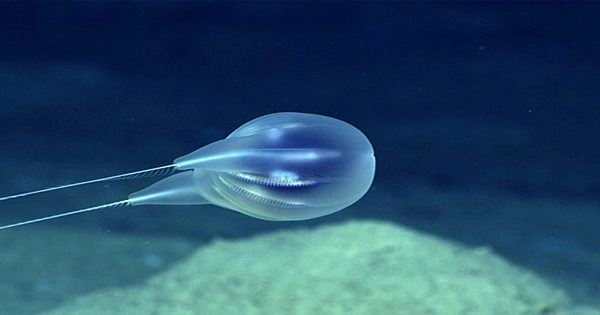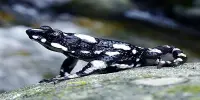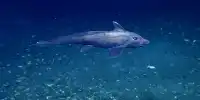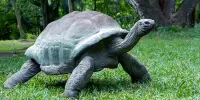Stop looking into space if you want to witness an extraterrestrial creature, and head to the ocean’s depths instead.
There are many strange and amazing species in the ocean’s depths, and as people go further down, they are finding more and more of them. Scientists discovered enough deep marine creatures in 2022 to fill an aquarium. Here are some of our favorites, including blue ooze, gummy squirrels, a spaghetti worm, and Jell-O fish.
Luminous lump of spaghetti: The online discussion was sparked by a strange aquatic creature with glowing orange, spaghetti-like tendrils.
The spaghetti worm, which belongs to the genus Biremis, was discovered by researchers from the Monterey Bay Aquarium Research Institute (MBARI) in 2012 while they were scuba diving in the Gulf of California off the coast of Mexico.
The worm that resembles pasta utilizes its vibrant tentacles to grab the minute bits of organic waste, commonly known as marine snow, that fall to the ocean floor. It has no eyes or gills.
The majority of spaghetti worms are underground dwellers that only emerge to scavenge for food using their noodle-like tentacles. However, this Biremis worm spends its entire life above the ocean’s surface and has been seen in the past swimming through the water or creeping along the seafloor to locate areas with an abundance of food.
Squid mom carries pearl-like eggs: Off the coast of California, a squid mother was seen in the extremely uncommon footage holding a gelatinous string of pearl-like eggs in her arms.
The deep-sea squid, an unidentified species in the genus Bathyteuthis, was discovered by MBARI researchers using a ROV about 56 miles (90 kilometers) off the coast at a depth of 4,560 feet (1,390 meters).
Squid mothers typically don’t carry or brood their eggs. The majority of females deposit their eggs on the ocean floor or in huge clumps of gelatin. Brooding is extremely uncommon because it probably increases the mother’s risk of being eaten, even though it might improve the chances that the eggs would hatch.
The overly protective mother may appear larger than her eggs in the photo, but in actuality, a squid’s mantle, which houses all of its vital organs, can only expand to a maximum length of 3 inches (7.5 centimeters).
Gummy squirrel: In the Pacific Ocean, scientists discovered a strange gelatinous organism that resembles a half-peeled banana. The so-called “gummy squirrel” (Psychropotes longicauda), which was around 2 feet (60 cm) long, is actually a sea cucumber.
A total of 55 specimens were gathered by researchers from the Natural History Museum in London after they combed the Pacific Clarion-Clipperton Zone, which is situated between Hawaii and Mexico.
A sea sponge in the shape of a tulip and a coral that is believed to be unique to the Atlantic Ocean are two other noteworthy specimens from the trip. Up to 39 of the organisms found may be members of previously unknown species.
Mysterious blue goo: After discovering strange, gooey critters on the seafloor near St. Croix, one of the U.S. Virgin Islands, scientists were left perplexed.
Using a ROV, National Oceanic and Atmospheric Administration (NOAA) researchers discovered several “blue goo” species while live-streaming the dive online. Between 1,335 and 2,005 feet (407 and 611 m) below the water’s surface, the mystery blobs were resting still on the ocean floor.
Researchers made a guess during the live stream as to what it might be. Soft corals and sea sponges were suggested, but no solution was accepted by all. One researcher jokingly said, “I can tell you it’s not a rock, but that’s all I can say.”
Weird-eyed strawberry squid: A brilliant red squid with unusual eyes was seen by MBARI researchers. The strawberry squid (Histioteuthis heteropsis) had one enormous, the yellow eye that was shaped like a bulb, and one small, black eye.
The odd-eyed cephalopod was discovered by the researchers using an ROV in Monterey Canyon, off the coast of California, at a depth of 2,378 feet (725 m).
The mismatched eyes of the squid give it a unique advantage in the deep ocean. The larger yellow eye scans the sky for shadows cast by animals above, while the smaller black eye peeks down to detect bioluminescent flashes from prospective prey and predators.
It’s interesting to note that H. heteropsis hatchlings have two eyes that are the same size at birth. The left eye grows larger as they mature into juveniles, while the right eye maintains its size. The left eye may be larger than the right eye by the time a person reaches maturity.
Alien “shopping bag”: Near Hawaii, a strange deep-sea critter with glowing Cheeto guts and the appearance of a floating plastic bag was discovered.
The floating, drifting organism was discovered by Nautilus Live researchers using an ROV at a depth of 7,221 feet (2,201 m) in the Marine National Monument southeast of Honolulu. The strange creature is actually an Elpidiidae sea cucumber, which scavenges marine snow that falls to the ocean floor.
The transparent species, which was swimming across the seafloor when it was discovered by scientists, has a fin-like appendage that aids in its mobility. It is unknown why the sea cucumber’s intestines, which are brilliant orange tubes, are so vibrant.
Translucent “Jell-O fish”: As they trawled the seafloor off the Aleutian Islands in Alaska, NOAA scientists were taken aback when they reeled in a fish with an odd appearance that resembled a jellyfish.
The translucent body of the gelatinous fish, also known as a blotched snailfish (Crystallichthys cyclospilus), was covered in ringed patches, and it featured an odd suction cup on its belly that served as a modified fin and allowed it to cling to the seafloor.
The blotched snailfish can survive in depths of up to 2,723 feet (830 meters). They can resist the crushing pressure of the deep water thanks to their jelly-like consistency, and their translucent bodies aid to conceal them from predators. But many aspects of their life history are still unknown to experts.
















